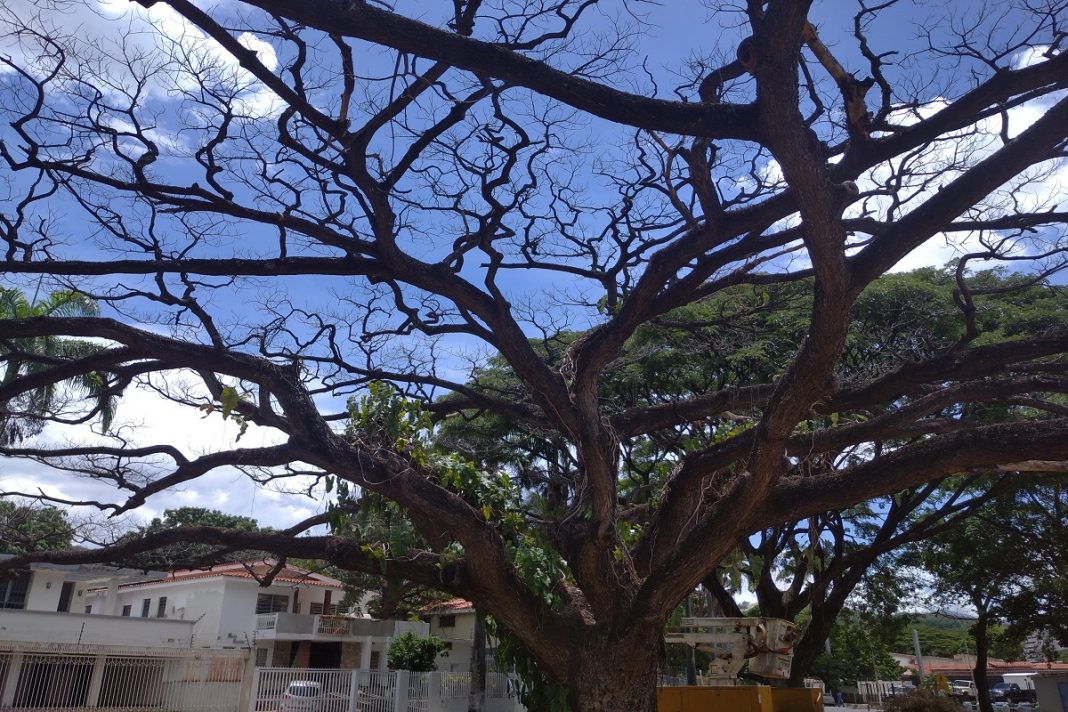–
Valencia has well-defined icons and symbols, as is the case of the emblematic samanes of the north zone. For more than six decades these trees have witnessed the evolution of the city and Valencians of several generations assume them as an unofficial natural heritage that identifies them.
Of the four specimens bigger and longest there are in the north of the capital of Carabobo, only three remain and one of those, the one in the La Viña vial, in front of the Movistar Tower, is in worrying condition: 60% of its crown is covered by withered leaves. This was determined by a multidisciplinary team made up of independent specialists and the Municipal Environmental Institute (IMA).
Everyone fears that the tragedy of the iconic samán of the island will be repeated, located between 107th Street and the main avenue of La Viña, of which only the trunk and dry branches remain. According to a study carried out last year by the Experimental Faculty of Sciences and Technology of the University of Carabobo (Facyt-UC), this specimen died from a fungus that caused deep injuries from the apical part to the center, not by poisoning as it initially transpired.
The one is in better condition It is the one between the Siglo XXI shopping center and the old Intercontinental Hotel (now Venetur), Esmeralda Mujica, a biologist graduated from the Central University of Venezuela (UCV) and resident of La Viña, reported in an interview with El Carabobeño citizen movement in search of the preservation of these specimens.
Although it was too late to save the samán from the main avenue of La Viña, which in December used to be a meeting point for recreation and entertainment for Valencians, Mujica along with other retired and active professionals in the scientific field decided to work for the recovery of the rest of the trees. “I must acknowledge the IMA, because they understood us.”
At the samán located between the shopping center and the hotel, at the request of the multidisciplinary team, last July the IMA applied a phytosanitary treatment which included fertilization. In addition, during the summer the leaves were distributed two meters from the trunk, as a carpet, to keep the soil moist. “It was important that the crews did not leave the leaves piled up next to the trunk,” explained the biologist.
Currently, the one that causes them the greatest concern is that of the La Viña vial. Although since October they were able to observe the deterioration that it presents, the mobility restrictions linked to the COVID-19 pandemic and the gasoline shortage prevented the team from acting during those months.
It was in mid-January that they again made an evaluation of this specimen, whose crown occupies 650 square meters. “This time you need people who really know about trees, because it is not an isolated situation. We already have two casesOne that died to us (the one on the main avenue of La Viña) and another that is deteriorated (the one with the vial in La Viña), but still with the leaves, “he said.
So far the causes of the deterioration of this second saman are not clear. To determine them phytopathologists were contacted, who are in charge of studying diseases in trees. On the other hand, the analyzes will be carried out at the Universidad Centroccidental Lisandro Alvarado (UCLA), in Lara, where a plant pathology laboratory still operates.
According to the spokeswoman, to take the samples that will be sent to UCLA they must first perform a supervised tree pruning, in the waning moon phase, which begins on February 4. That same day the multidisciplinary team will start fertilization and in parallel will apply a healing product after pruning to prevent the entry of other pathogens that may affect it.
While the pruning arrives, next to the IMA they are carrying out inter-daily irrigation and controlling some pests, such as ants and bachacos.
“We are evaluating trees, because there is also the possibility that it is a specific disease of the Samanes“Said the specialist, while reporting that three other specimens in the city also died: one in the Las Chimeneas distributor and two in the Plaza de las Esculturas.
–


